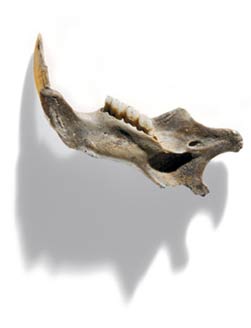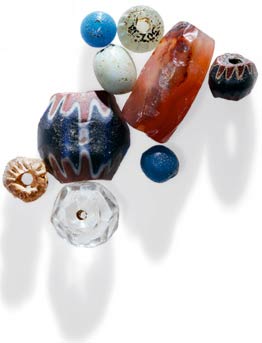What did they bring to the new world?
Surely they knew many unusual things waiting for them. Before the Englishmen sailed to Virginia in the early years of the 17th century, all previous European attempts to occupy the coast between Nova Scotia and Florida failed. But investors in London, Virginia, still find thousands of people ready to take on the challenge.
When packing luggage, colonists envisioned a long life in a prosperous and prosperous colony. Men carry pots and tin jars in a sea chest with iron and steel to make collar buttons. Women quality dresses and bed sheets full of their suitcases. People wore a ceramic cup, others carried a small windmill model as a pastime.
Their boats were filled with cranes of shovels, axes, barrels of muskets, armor and tools to hunt down useful things: jars containing medicinal plants, pots to produce water fine, and distillers to distill the most sought after thing at that time - gold.


Entertainment .Soldiers at small remote bases often play betting with bone dice, ivory or lead to kill time - this hobby was banned in 1611 to restore discipline.
Traces of faith.A black stone crucifix may belong to some Christians who preach to the immigrants.And perhaps even more missionary purposes for the Indians.


Hunger period. When the Powhatan people besieged Jamestown during the winter of 1609-1610, isolated immigrants had to eat horse meat, dogs, cats, and even black mice that they did not knowingly bring to Virginia on the trains. Many Britons died of illness because of hunger, thirst or drinking water from contaminated streams and wells. The survivors were ready to give up to return to England, but when the spring came, there were more new migrants and food supplies for them.
Trade exchange.The British have built friendships with Powhatan aboriginal people by exchanging goods such as Venetian glass and stone beads for stringing, metal tools, weapons or coins, such things. Aboriginal people judge as a sign of social rank.But this relationship worsened when the British forced the aboriginals to sell their food during the drought and the Powhatan realized the intention of the British to occupy their land.
Soon, people reclaimed disillusionment. One by one, each business plan successively failed, and those who had longed for wealth could only pray to survive. Many colonists were killed within a few months at the edge of the sea. For every 4 people who come to Jamestown around 1607 to 1624, 3 people die from epidemics, starvation and fighting Indians.
Until recently, there were very few documents recorded about them. Since 1994, the Jamestown archaeologists led by William Kelso have uncovered a valuable treasure trove of these people: a million ancient artifacts have clarified every detail of life. and the death of immigrants, the aristocracy and the commoners, when they attempted to establish a colony later to become the first permanent settlement of the British in the North of America, it was water. America today.
Bly Straube, the curator of a museum, said, " It's like finding a lost letter ." Few, little by little, everything the colonists had brought in the Atlantic transits, buried in their bodies in strange lands in Virginia, the wills were buried with the hope that they brought along with a dangerous journey.

Study history.A distorted handmade ashtray tray was found in a hole in a defensive position as evidence for life in Jamestown between 1610 and 1640. Clockwise from the top left: those British stone used as a balancing device for boats when crossing the sea and is also a tool to create fire;the shells of the Chesapeake oyster that the migrants had eaten;Iron nails were forged to be used for construction, longitudinal clay pipes with European pottery, and severed copper pipes were remade into decorations for Indian Aborigines.Scattered remnants of imported pig bones, Eastern fish boxes and turtles;and corals from the West Indies (a stop for all the Atlantic ships).

The British came to Virginia to seek valuable export opportunities to help them develop their economies in the 17th century. After trials and mistakes they discovered the best possibility of growing sweet-smelling tobacco.Their beautiful pipes to smoke this medicine have been unearthed at Jamestown.The group in Virginia failed, but in the end, the Jamestown colony was successful - thanks to its valuable gold crop.

Status symbol. Jamestown leaders wanted to establish an English-style society in Virginia. Men at the settlement wore items to show their rank, like carved seal bones to print their initials with wax. An image of a boy who is dancing can be a gift for Indian Aboriginal people with the meaning of British " civilization ".A toothpick and a head to clean silver ears is a symbol of the English aristocracy.


Complex hand-made keys are used to lock the chest of items.
A brass iron ring, needles and scissors from Nurnberg, Germany were taken to Jamestown via Don Don.


Surrounded, isolated.The Powhatan are more crowded, the British have retreated behind the cliff to hide while being attacked, guarding the fort with the musket and sharp iron strikes buried in the ground.The iron marbles of cannonballs will be available to any enemy approaching: Spanish Navy weapon.
A German stone vase came from Frechen and was brought to London before it was brought to Jamestown.
- Technology firms look for 'visas' for virtual residents
- Britain and France want to bring nuclear power around the world
- Video: What happens if you bring a part of the Sun to Earth?
- These designs bring humanity to the new world
- How did the Wright brothers change the world?
- NASA plans to bring settlers on Mars
- Scientists are angry because NASA canceled the mission to bring robots to the Moon
- The greatest explorers in the world
- The monasteries are unique in the world
- Unusual inventions
- 'Prophecy' plans to change the world in 2050
- 'Secrets' of astronauts
 Discovered an ancient centipede fossil 99 million years old
Discovered an ancient centipede fossil 99 million years old Discovered bat-like dinosaurs in China
Discovered bat-like dinosaurs in China Discovered a 200-year-old bronze cannon of the coast
Discovered a 200-year-old bronze cannon of the coast Discover 305 million-year-old spider fossils
Discover 305 million-year-old spider fossils